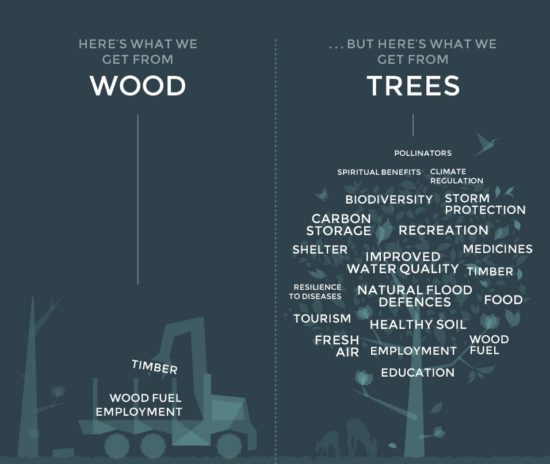
Thought Piece, Natural Capital Evaluations
A certain credit card has had an advertising campaign which has used the notion that there are certain things in life which we hold so dear that we cannot put a price on them. Currently there are areas of natural capital which fall into the same category: priceless. So how, then, can we begin to find a price tag which reflects accurately what the value is?
In the UK, the Environment Agency’s National Environmental Assessment Services has the difficult task of evaluating the protection of our natural environment, invariably with an associated monetary evaluation. One person’s financial asset is another’s beloved open space.
As the route of HS2 is revealed, there are arguments over the fact that ancient woodland will be destroyed. How should this be compensated, and indeed, can it be compensated? The naivety of the observation that ancient woodland should be replanted elsewhere demonstrates a sad lack of understanding of ancient woodland. By definition newly planted trees cannot be ancient woodland, with all the integral biodiversity associated with it. The Woodland Trust have restated the case from Natural England[1] that within the planning for HS2 each hectare of ancient woodland destroyed should be compensated for by replanting with 29 hectares of ‘equivalent’ woodland. It will only be true compensation if responsibility is taken for its future protection and nurture. Is 29 hectares sufficient? How can we arrive at such a ‘value’?
The Natural Capital forum have a wonderful graphic which demonstrates the true value of trees:

Infographic from Natural Capital Forum – Can’t see the TREES for the WOOD? Natural capital explained… (designed by www.weareglidden.com)
The UN places value on the raw timber at a global level as being $0.4trillion, compared with the value provided by the trees at $3.7, on carbon sequestration alone. At a local level, a study carried out in the UK[2] finds that timber has a falling price tag, but an increasing importance for carbon sequestration. As the UK is a signatory to the Kyoto convention, it is possible that this valuation may become more important than the timber. As we hold other countries to account for their seemingly indiscriminate timber felling, it is important to understand global interconnectivity.
But what of the value beyond the hard economics of selling timber, and what of wider natural capital? In the face of climate change and the potential threat posed by the increased severity of storms, we are beginning to remember what we once knew: trees help to alleviate the effect of heavy rainfall and flooding[3], not just in the UK, but further afield[4]. Money lost by insurance companies in the pay-out for floods may have been avoided if the economics of tourism, in the case of Sri Lanka, or urbanization closer to home, had taken account of ecosystem services[5].
Other values which have a monetary element, but which are rarely considered, are in health and wellbeing. Moving people from being dependent upon treatment with drugs which have a high monetary burden as well as wider environmental impact is beneficial in all ways. Increasing access to greenspace in the urban environment is crucial to this shift. Studies in Bradford[6] have shown that pregnant women have less depression and better birth outcomes when closer to greenspace. Patients in hospital have a faster recovery time when they can see green space from their window[7]. The Centre for Sustainable Healthcare is working to promote the public engagement between healthcare providers and commissioners and the public, to make greater use of greenspace for green prescribing[8]. The pay back for not having to prescribe drugs, or having someone at work more rapidly, can be calculated to demonstrate their financial value to society, though the benefit to the people concerned is probably incalculable.
Although throughout Britain there are still vast tracts of open countryside (albeit under agricultural industry), as a nation we are becoming more urbanized. Homes are in short supply. The green belt was put in place through the planning process many years ago, in order to ensure that a clear gap was identifiable between urbanization and agricultural land[9]. The green belt is currently under pressure for building. However, it should not be a choice between green space and homes. Good planning can take into account designing- in pleasant and safe walking routes for people, parks for meeting and play, trees to absorb carbon, provide shade and reduce flooding, and allotments for people to work to grow their own food. Denying them of this basic human instinct means that people will take matters into their own hands, such as Guerilla Gardening and Incredible Edible, in Manchester[10].
Ensuring that children get adequate outdoor play is essential to their health in an increasingly obesogenic society[11] and lays down positive behavior for future good health. When the NHS is severely stretched, reducing the financial burden through behavior change should be considered essential.
But what of valuing parks and open spaces for their own sake[12]? How do we find a value which equates to ‘I like it here’? Unlike the credit card referenced at the beginning of the piece, we cannot borrow against tomorrow as far as nature is concerned. Perhaps some things are quite simply: priceless. To quote Mark Twain, ‘Buy land: they ain’t making any more of it’.
Gillian Gibson Msc Cenv FIEMA, Independent consultant and trainer, Gibson Consulting and Training
References:
[1] www.woodlandtrust.org.uk/blogs/press-centre/2016/11/natural-england-advice-to-hs2-on-ancient-woodland/
[2] UK NEA Economic Analysis Report Valuation of services from Woodlands: Valatin & Starling 2010
[3] www.birmingham.ac.uk/news/latest/2016/03/tree-planting-alleviates-flooding.aspx
[4] news.bbc.co.uk/1/hi/sci/tech/4547032.stm
[5] Spalding M, McIvor A, Tonneijck FH, Tol S and van Eijk P (2014) Mangroves for coastal defence. Guidelines for coastal managers & policy makers. Published by Wetlands International and The Nature Conservancy. 42 p
[6] J Epidemiol Community Health doi:10.1136/jech-2015-205954
[7] mdc.mo.gov/sites/default/files/resources/2012/10/ulrich.pdf
[8] sustainablehealthcare.org.uk/what-we-do/green-space-and-health
[9] planningguidance.communities.gov.uk/blog/policy/achieving-sustainable-development/delivering-sustainable-development/9-protecting-green-belt-land/
[10] www.urbanallotments.eu/fileadmin/uag/media/STSM/Binder_shortreportSTSM_final.pdf
[11] www.strath.ac.uk/whystrathclyde/mediacentre/getchildrenplayingoutdoorsstudysays/
[12] www.nationalgeographic.com/magazine/2016/04/nature-urban-national-parks/
Author Bio:
Gillian is a Chartered Environmentalist with an extensive background in the health services and public bodies. She is an accomplished and effective trainer with professional experience in further and higher education. As well as delivering a wide range of environmental and sustainable development courses, Gillian teaches sustainability to students on the Masters in Public Health course at Liverpool John Moores University.
Gillian is a practising environmental consultant with detailed, practical knowledge and experience in a wide range of fields including the health effects associated with IPPC installations.
Gillian is a Fellow of the Institute of Environmental Management and Assessment (IEMA). As well as serving on the professional standards committee of that organisation, she also serves as a Full Member assessor and Chartered Environmentalist assessor for the organisation.